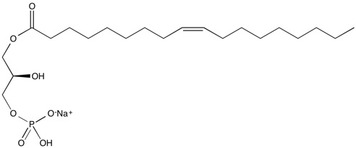Lysophosphatidic acid (Oleyl form) | Endogenous LPA receptor agonist
NMR (Conforms)

Available Options
| size : | Price | Quantity | |
|---|---|---|---|
| 5 mg | $60.00 | ||
| 25 mg | $240.00 |
Lysophosphatidic acid (325465-93-8) is a multifunctional intercellular bioactive phospholipid.1 Stimulates the growth of a variety of cells including fibroblasts, vascular smooth muscle cells, endothelial cells and keratinocytes among others.1 Acts as a proliferative and anti-apoptotic factor.2 Lysophophatidic acid is an agonist at LPA1 (EDG-2), LPA2 (EDG-4) and LPA3 (EDG-7) receptors.3 LPA-primed astrocytes induce axonal outgrowth of cortical progenitors.4
References/Citations:
1) Moolenaar et al. (1995), Lysophosphatidic acid, a multifunctional phospholipid messenger; J. Biol. Chem., 270 12949
2) Levine et al. (1997), Lysophosphatidic acid; a novel growth and survival factor for renal proximal tubular cells; Am. J. Physiol., 273 F575
3) Goetzl and An (1998), Diversity of cellular receptors and functions for the lysophospholipid growth factors lysophosphatidic acid and sphingosine 1-phosphate; FASEB J., 12 1589
4) Spohr et al. (2014), LPA-primed astrocytes induce axonal outgrowth of cortical progenitors by activating PKA signaling pathways and modulating extracellular matrix proteins; Front Cell Neurosci., 8 296
NMR (Conforms)
Safety Data Sheet:
Product Data Sheet:
Materials provided by Focus Biomolecules are for laboratory research use only and are not intended for human or veterinary applications. Please note that we do not sell to individuals and that all orders placed by non-research organizations will incur a $20 restocking/refund fee
Lysophosphatidic acid (325465-93-8) is a multifunctional intercellular bioactive phospholipid.1 Stimulates the growth of a variety of cells including fibroblasts, vascular smooth muscle cells, endothelial cells and keratinocytes among others.1 Acts as a proliferative and anti-apoptotic factor.2 Lysophophatidic acid is an agonist at LPA1 (EDG-2), LPA2 (EDG-4) and LPA3 (EDG-7) receptors.3 LPA-primed astrocytes induce axonal outgrowth of cortical progenitors.4
References/Citations:
1) Moolenaar et al. (1995), Lysophosphatidic acid, a multifunctional phospholipid messenger; J. Biol. Chem., 270 12949
2) Levine et al. (1997), Lysophosphatidic acid; a novel growth and survival factor for renal proximal tubular cells; Am. J. Physiol., 273 F575
3) Goetzl and An (1998), Diversity of cellular receptors and functions for the lysophospholipid growth factors lysophosphatidic acid and sphingosine 1-phosphate; FASEB J., 12 1589
4) Spohr et al. (2014), LPA-primed astrocytes induce axonal outgrowth of cortical progenitors by activating PKA signaling pathways and modulating extracellular matrix proteins; Front Cell Neurosci., 8 296
Related Lysophospholipid Mediators
Download
Calculate the molar concentration, mass or volume in a solution.
Concentration × Volume × Molecular Weight = Mass
Focus Biomolecules • Plymouth Meeting, PA USA • 1-855-FOCUS21
Focus Biomolecules
Plymouth Meeting, PA USA
1-855-FOCUS21
Website Created by Advanta Advertising LLC.

